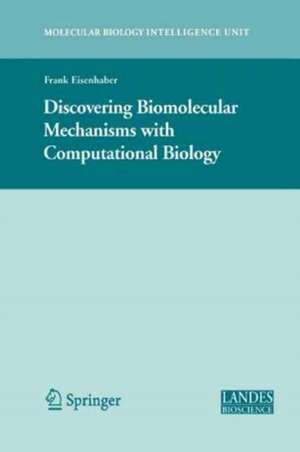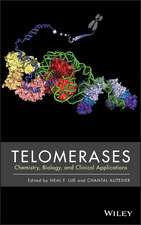Discovering Biomolecular Mechanisms with Computational Biology: Molecular Biology Intelligence Unit
Editat de Frank Eisenhaberen Limba Engleză Paperback – 19 noi 2010
Discovering Biomolecular Mechanisms with Computational Biology is essential reading for life science researchers and higher-level students that work on biomolecular mechanisms and wish to understand the impact of computational biology for their success.
| Toate formatele și edițiile | Preț | Express |
|---|---|---|
| Paperback (1) | 775.64 lei 38-44 zile | |
| Springer Us – 19 noi 2010 | 775.64 lei 38-44 zile | |
| Hardback (1) | 944.99 lei 6-8 săpt. | |
| Springer Us – 13 iun 2006 | 944.99 lei 6-8 săpt. |
Din seria Molecular Biology Intelligence Unit
- 5%
 Preț: 663.60 lei
Preț: 663.60 lei - 18%
 Preț: 1229.10 lei
Preț: 1229.10 lei - 5%
 Preț: 1091.14 lei
Preț: 1091.14 lei - 24%
 Preț: 775.98 lei
Preț: 775.98 lei - 18%
 Preț: 1226.60 lei
Preț: 1226.60 lei - 15%
 Preț: 642.51 lei
Preț: 642.51 lei - 5%
 Preț: 1098.48 lei
Preț: 1098.48 lei - 15%
 Preț: 638.11 lei
Preț: 638.11 lei - 18%
 Preț: 944.99 lei
Preț: 944.99 lei - 5%
 Preț: 716.09 lei
Preț: 716.09 lei - 20%
 Preț: 552.98 lei
Preț: 552.98 lei - 5%
 Preț: 1096.62 lei
Preț: 1096.62 lei - 5%
 Preț: 1097.71 lei
Preț: 1097.71 lei - 18%
 Preț: 942.94 lei
Preț: 942.94 lei - 18%
 Preț: 1222.49 lei
Preț: 1222.49 lei - 5%
 Preț: 1408.97 lei
Preț: 1408.97 lei - 18%
 Preț: 947.04 lei
Preț: 947.04 lei - 5%
 Preț: 1094.60 lei
Preț: 1094.60 lei - 18%
 Preț: 945.79 lei
Preț: 945.79 lei - 24%
 Preț: 1053.39 lei
Preț: 1053.39 lei - 24%
 Preț: 786.18 lei
Preț: 786.18 lei - 24%
 Preț: 789.89 lei
Preț: 789.89 lei - 18%
 Preț: 945.62 lei
Preț: 945.62 lei - 5%
 Preț: 1095.90 lei
Preț: 1095.90 lei - 5%
 Preț: 1429.27 lei
Preț: 1429.27 lei - 24%
 Preț: 817.70 lei
Preț: 817.70 lei - 5%
 Preț: 1104.84 lei
Preț: 1104.84 lei - 18%
 Preț: 947.85 lei
Preț: 947.85 lei - 15%
 Preț: 640.88 lei
Preț: 640.88 lei - 18%
 Preț: 951.29 lei
Preț: 951.29 lei - 5%
 Preț: 1095.73 lei
Preț: 1095.73 lei - 18%
 Preț: 950.33 lei
Preț: 950.33 lei - 18%
 Preț: 946.55 lei
Preț: 946.55 lei - 18%
 Preț: 952.89 lei
Preț: 952.89 lei - 5%
 Preț: 714.63 lei
Preț: 714.63 lei - 18%
 Preț: 946.41 lei
Preț: 946.41 lei - 18%
 Preț: 947.85 lei
Preț: 947.85 lei - 18%
 Preț: 956.03 lei
Preț: 956.03 lei - 5%
 Preț: 1293.02 lei
Preț: 1293.02 lei - 5%
 Preț: 1098.63 lei
Preț: 1098.63 lei - 18%
 Preț: 944.19 lei
Preț: 944.19 lei - 18%
 Preț: 950.52 lei
Preț: 950.52 lei - 24%
 Preț: 782.70 lei
Preț: 782.70 lei - 18%
 Preț: 953.65 lei
Preț: 953.65 lei - 15%
 Preț: 640.06 lei
Preț: 640.06 lei - 5%
 Preț: 1610.67 lei
Preț: 1610.67 lei - 18%
 Preț: 947.35 lei
Preț: 947.35 lei - 18%
 Preț: 1231.32 lei
Preț: 1231.32 lei - 15%
 Preț: 649.06 lei
Preț: 649.06 lei - 18%
 Preț: 1231.16 lei
Preț: 1231.16 lei
Preț: 775.64 lei
Preț vechi: 1020.57 lei
-24% Nou
Puncte Express: 1163
Preț estimativ în valută:
148.44€ • 153.34$ • 123.54£
148.44€ • 153.34$ • 123.54£
Carte tipărită la comandă
Livrare economică 21-27 martie
Preluare comenzi: 021 569.72.76
Specificații
ISBN-13: 9781441941770
ISBN-10: 1441941770
Pagini: 160
Ilustrații: XI, 147 p. 42 illus., 1 illus. in color.
Dimensiuni: 165 x 248 x 8 mm
Ediția:Softcover reprint of hardcover 1st ed. 2006
Editura: Springer Us
Colecția Springer
Seria Molecular Biology Intelligence Unit
Locul publicării:New York, NY, United States
ISBN-10: 1441941770
Pagini: 160
Ilustrații: XI, 147 p. 42 illus., 1 illus. in color.
Dimensiuni: 165 x 248 x 8 mm
Ediția:Softcover reprint of hardcover 1st ed. 2006
Editura: Springer Us
Colecția Springer
Seria Molecular Biology Intelligence Unit
Locul publicării:New York, NY, United States
Public țintă
ResearchCuprins
Prediction of Post-translational modifications from amino acid sequence: Problems, pitfalls, methodological hints.- Deriving Biological Function of Genome Information with Biomolecular Sequence and Structure Analysis.- Reliable and Specific Protein Function Prediction by Combining Homology with Genomic(s) Context.- Clues from Three-Dimensional Structure Analysis and Molecular Modelling.- Prediction of Protein Function.- Complementing Biomolecular Sequence Analysis with Text Mining in Scientific Articles.- Extracting Information for Meaningful Function Inference through Text-Mining.- Literature and Genome Data Mining for Prioritizing Disease-Associated Genes.- Mechanistic Predictions from the Analysis of Biomolecular Networks.- Model-Based Inference of Transcriptional Regulatory Mechanisms from DNA Microarray Data.- The Predictive Power of Molecular Network Modelling.- Mechanistic Predictions from the Analysis of Biomolecular Sequence Populations: Considering Evolution for Function Prediction.- Theory of Early Molecular Evolution.- Hitchhiking Mapping.- Understanding the Functional Importance of Human Single Nucleotide Polymorphisms.- Correlations between Quantitative Measures of Genome Evolution, Expression and Function.
Caracteristici
Contributors examine how sequence analysis becomes even more powerful if it is combined with automated scientific text mining (for the prediction of gene function and gene-disease association), with the analysis of expression data or allele occurrences (single-nucleotide polymorphisms) and frequencies Summarizes non-trivial theoretical predictions for regulatory and metabolic networks that have received experimental confirmation Includes supplementary material: sn.pub/extras















